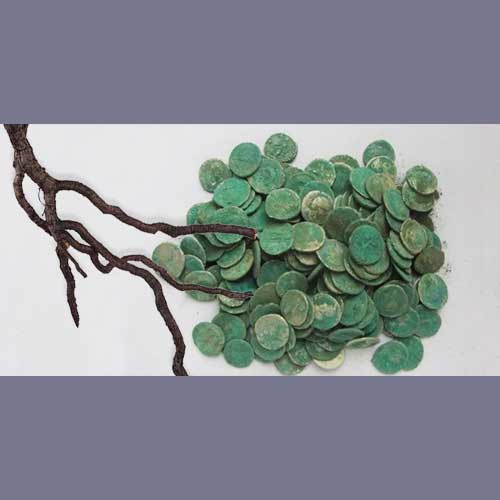Bulgaria Receives a Sweet Surprise in the Form of Ancient Hoard of Roman Silver Coins
2017-11-17 Fri
There are so many nasty things that need to be cleared in the world and it is only then you will find some sweet surprises. Something like that happened in Mezdra, Bulgaria where neighbours complained that the yard next door was unkempt, so the authorities walked in and began clearing the overgrown lot. During the process of uprooting one particularly old plum tree, a cache of well-patinated Ancient Roman silver coins was discovered in the tangle of roots beneath it.The town, which is located in the northeast of the Bulgarian capital Sofa, had long been the hypothetical location of an imperial Roman settlement, but archaeologists had not yet found conclusive evidence. The place where the coin was found, was not far from the Kaleto Fortress, which is a noted archaeological site inhabited since prehistoric times on through the medieval era. Bronze coins (along with other objects) of the Roman Empire have been found within the fortress itself, including coins of the emperors Domitian (ruled 81-96 CE), Claudius II Gothicus (r. 268-270), and Probus (r. 276-282)–but until the silver coins were unearthed in late August, proof of a settlement had eluded scholars.
The almost 200 coins of the hoard consist of denarii and antoniniani dated to the first and third centuries CE. At the front end of this range are coins representing the emperors Nero (r. 54-68), Galba (r. 68-69), Vitellius (r. 69) and Vespasian (r. 69-79). Silver denarii of the pretender Clodius Albinus (claimed the throne in 193 and again 196-197) and coins of the emperor he fought against, Septimius Severus (r. 193-211) are also present. The most recent coinage included in the cache were minted under the authority of Severus Alexander (r. 222-235).
Many coins feature the portraits of several of the emperors’ wives. Many were minted in Syria and show signs of circulated wear, while others were not used at all. A portion of the coins is of rare types. The hoard itself may have been buried to hide the coins from the third-century invasions by the Goths, Germanic tribes who made several inroads into the Roman Empire over the course of several centuries.
A local archaeologist, Plamen Ivanov, said that the 200-year span of coins in the collection demonstrates the importance of the Roman settlement in Mezdra, perhaps even serving as a regional Roman treasury.
Unfortunately, there is some controversy regarding the discovery.
When they stumbled upon the coins, they were inside a ceramic jar, but workers, in an attempt to free the treasure from the root system of the tree, used a pickax and apparently damaged the container.
The discovery was made in August but was not reported to local authorities until two weeks later. At that time, 183 coins were taken to the Vrasta Regional Museum of History. Four more individual coins from the hoard were given over to the museum a few days after the official announcement of the find in mid-September. And it was only after museum experts had enough time to clean and inspect the coins that any were shown to the news media on October 16.
The museum firmly believes that the hoard consisted of about 1,000 coins as they have taken photos of the coins on site. Therefore, the museum had asked the locals if they had the coins, however, police are looking into it.
The Vrasta Regional Museum is now conducting an emergency excavation of the property to find more evidence of the Roman settlement.
It is also not the only example of a Roman coin hoard found in Bulgaria. Another jar of Roman silver was found in the ruins of the ancient city of Serdica in modern Sofia in 2015. Archaeologists have speculated that the 2015 find may have been at the location of the ancient mint of Serdica.
Latest News
-
Gold Pagoda of Vijaynagar Empire King Deva Raya I
2024-04-10 WedKing Deva Raya I of the Vijayanagara Empire was a patron of Kannada literature and architecture. He ...
-
Silver Denarius of Septimus Severus
2024-04-05 FriLucius Septimius Severus served as the Roman emperor from 193 to 211 AD. Severus sat on the throne o...
-
Extremely rare 'Malaharamari' type Gold Gadyana of King Guhalladeva-III Sold for INR 611000
2024-04-03 WedTribhuvanamalla, also known as Guhalladeva III, was the ruler of the Kadamba dynasty. His reign coin...
-
90 Years of RBI
2024-04-02 TueOn 1st April, PM #Modi unveiled a special commemorative coin marking 90 Years since the foundation o...
-
Silver Denarius of Julia Mamaea
2024-04-02 TueJulia Avita Mamaea, a Christian Syrian noblewoman, was the mother of Roman Emperor Alexander Severus...

